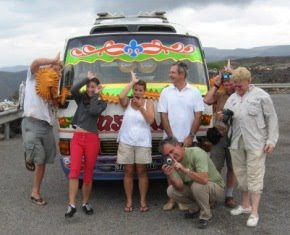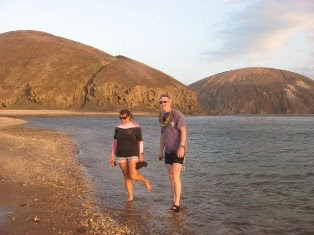At 06:30 on the first morning the whole team were up and raring to go as we boarded Deli’s support tenders and headed across Arta Bay towards the French Foreign Legion camp where in 2006 we had regularly encountered whale sharks..... and sharks there were! Between the two boats we achieved some 18 photo ID encounters (later confirmed as 8 individuals) with the characteristically small whale sharks found around Djibouti and so the expedition was off to a very good start.
On returning to Deli for breakfast we were told that another live-aboard was seeing lots of sharks in the next major bay further west and so we felt obliged to move Deli down to this area for the next session. Heading out in the tenders again we were keen to see if the reports of a big feeding aggregation off Acacia beach were true and much to our surprise they were! There were whale shark tails and dorsal fins everywhere....

What is the collective noun for a group of whale sharks? A Shed Load seemed appropriate!
Luke and David were on photo ID duties while Katie drew the short straw of recording by default, she had brought along a UK cold and so was out of the water for a few days.... just as well as the boys notched up a total of 62 in-water photo ID encounters in two and a half hours.... I think the expression used was Manic!! Dan and Tom, the two cameramen from Save Our Seas were suitably impressed but were heard muttering about too much plankton, too many sharks, swimming too fast, not enough time, not enough sun, too much sun etc. etc. While on the other tender Daniel Jouannet from Megaptera with Luis, Flora and their son Germinal were matching David and Luke shark for shark with both photo and video IDs.... The only really unhappy voice was Katie’s as she was forced to sit on the boat and watch but after much pleading she was released to play in what she called a ‘whale shark sandwich’ (take three whale sharks and one Katie and press together)!
After the adrenalin rush of the last two and a half hours, the return to the boat was a somewhat subdued affair with the dawning realisation that writing up the data sheets for 62 encounters was going to take many hours, not to mention working through the photos and running them through the I3S photo ID program. We were going to have to re-think our approach for the afternoon as both Luke and David knew they had multiple encounters with the same sharks although there were obviously many different sharks around.

For the third and final session of the day it was agreed that a combined photo ID and biopsy routine would be run with Luke taking the photo IDs, David taking biopsies and Katie keeping track of everything on the record sheets. So session three in the afternoon was awaited with a mixture of excitement and dread as if the same encounter level was maintained the next two weeks were going to be spent working through the data instead of photographing more sharks! The afternoon session was busy but nowhere near as manic as the previous one... there were lots of sharks around but the feeding frenzy had abated to some extent and the photo ID / biopsy approach slowed down the speed of activities and ensured the maximum amount of data was captured; in total 27 sharks were encountered and 10 biopsies taken.
A daily work-plan was developed so that tasks that needed to be done immediately were taken care of, such as writing up the data sheets and separating out photos for each encounter; the back ground tasks of fingerprinting and photo ID matching would be done on an as and when possible basis...
All photos courtesy Luke Riley
 Decan is a non-governmental organisation set up by local vets to provide a sanctuary to local wildlife in particular the big cats such as Cheetahs and Lynx that are losing their natural habitats through urbanisation and grazing by goats and cattle.
Decan is a non-governmental organisation set up by local vets to provide a sanctuary to local wildlife in particular the big cats such as Cheetahs and Lynx that are losing their natural habitats through urbanisation and grazing by goats and cattle. inhabited by some 16 species of local birds.
inhabited by some 16 species of local birds.  These salt pans are mined by nomadic people who transport the salt to Ethopia by camel train, an ages old tradition that continues to this day.A more recent trade is the sale of curios to tourists but not plastic nic-nacs made in some factory... lots of fantastic crystals and geodes found gleaned from the surrounding countryside with quaint model cars and buses carved from local pumice. One rather odd addition to this array of collectibles are salt crystal structures such as goat skulls that are placed into the lake for several months and recovered and dried to form spectacular if somewhat macabre souvenirs!
These salt pans are mined by nomadic people who transport the salt to Ethopia by camel train, an ages old tradition that continues to this day.A more recent trade is the sale of curios to tourists but not plastic nic-nacs made in some factory... lots of fantastic crystals and geodes found gleaned from the surrounding countryside with quaint model cars and buses carved from local pumice. One rather odd addition to this array of collectibles are salt crystal structures such as goat skulls that are placed into the lake for several months and recovered and dried to form spectacular if somewhat macabre souvenirs!























